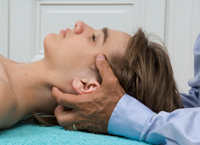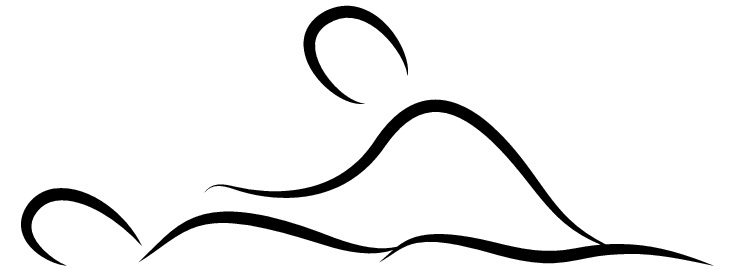Physiotherapy

Therapist’s skills are particularly suitable for :
- Traumatology and Sports injuries : fractures, dislocations, sprains, tendonitis, muscle injuries, …
- Orthopedy and postural rehabilitation : malformations, deformations, deviation of the vertebral column (kyphosis, scoliosis …), growth’s pain (Osgood Schlatter, Sever) …
- Rheumatology : joints or bones diseases, pain syndromes, neuromuscular disorders, pain associated with osteoarthritis …
- Pneumology : lung diseases, respiratory syndromes, bronchiolitis, asthma…
Click on a banner for more infos...
Postural rehabilitation – Muscular chains
The great interest in this method is that it involves the entire anatomy from the head to the toes.
This method is based on a complete examination which highlights tension points in different areas of the body, on the level of each of the chains.
It is therefore a manual treatment method :
– to free these areas of tension
– to return good tissue mobility in the different chains
– to restore better function
– to restore better stability
This method is suitable for all kind of patients :

– sports people to improve the reliability and performance of their movements.
– generally used for most of the back problems (arthrosis, hernia, sciatic syndrome…)
– active, old or sedentary people, in order to prevent or sooth physical or organic malfunctions as well as the effects of osteoarthritis.
 The Shock Waves therapy uses single acoustic pressure waves, to treat musculoskeletal pathologies.
The Shock Waves therapy uses single acoustic pressure waves, to treat musculoskeletal pathologies.
Indications are :
- Tendonitis
- Calcifying tendonitis
- Tennis Elbow or Golf Elbow
- Subacromial pain syndrom
- Greater trochanteric pain syndrom
- Medial tibial stress syndrom
- Osgood Schlatter disease
- Plantar fasciopathy
 The vestibular system includes sensors in the inner ear which detect and transmit information about the position and the movements of the head in the space.
The vestibular system includes sensors in the inner ear which detect and transmit information about the position and the movements of the head in the space.
The information travel to different parts of the central nervous system in order to allow daily life activities such as walking and bending forward.
In order to maintain static and dynamic balance, the vestibular system works with numerous systems (sensorial and motor) and higher cognitive functions.
The vestibular rehabilitation engulfs a combination of therapeutic technics known as first line treatment for balance disorder such as vertigo (spinning sensation) associated with nausea, instability, body deviation and oscillopsia (jumping image while moving).
Your GP could refer you in case of:
- Benign paroxysmal positional vertigo (BPPV)
- Vestibular neuritis
- Menière’s disease
- Vestibular hypofonction
- Instability
- Falls in the elderly
 The McKenzie method is a comprehensive system of evaluation and treatment for musculoskeletal disorder with a mechanical dominant clinical presentation. We assess and treat spine problem as well as upper and lower extremities.
The McKenzie method is a comprehensive system of evaluation and treatment for musculoskeletal disorder with a mechanical dominant clinical presentation. We assess and treat spine problem as well as upper and lower extremities.
A lot of aches in the spine and extremities have a “mechanical” origin. They are the result of postures we adopted, the accumulation of movements and forces we are under in our daily activities. With the help of a systematic assessment, the New Zealander physical therapist Robin McKenzie noted that in order to treat mechanical pain, simple exercises and postural modification might help and restore function.
Respiratory rehab (babies, adults)
Respiratory physiotherapy normalises and maximises your breathing function through breathing control exercises and re-education, postural exercises, sputum clearance techniques and education.
Typical conditions we can treat are: 
- bronchiolitis, bronchitis of new borns & babies
- hyperventilation Syndrome
- asthma
- breathing dysfunctions
- bronchiectasis
- Chronic Obstructive Pulmonary Disease (COPD)
- pulmonary rehabilitation
 Manual therapy is a specialised field in physiotherapy. It consists of an individualised therapeutic approach where a detailed evaluation of the joints, muscles, soft tissues around joints and nerve tissues are carried out.
Manual therapy is a specialised field in physiotherapy. It consists of an individualised therapeutic approach where a detailed evaluation of the joints, muscles, soft tissues around joints and nerve tissues are carried out.
Following this examination, a rehabilitation program is established based on the patient’s specific needs, taking into account his age, life style and physical activities.
Manual therapy, as its name indicates, implies the use of the hands to evaluate and treat. Many years of post-graduate training are required to develop expertise in this field.
A variety of techniques are used in manual therapy : soft tissue techniques, massage, mobilisations and manipulations.
The goal of these techniques is to regain movement and function as well as to decrease pain. Soft tissue techniques (specific massage techniques) are used to relax tight muscles, break down scar tissue and increase circulation. Articular mobilisations vary in speed and amplitude and can be applied to all joints (for example – knees, shoulders, spine).
Some mobilisations are of very small amplitude and are done very lightly. These are best used when the condition is more irritable and the intensity of the pain is a major issue. Manipulations are rapid short amplitude movements and they are mainly used when stiffness is a major issue or when there is a joint fixation.

Physiotherapists are known as movement specialists and they are best trained to prescribe therapeutic exercises to improve posture, muscle strength, mobility, endurance or motor control.
Specific exercises, based on the patient’s condition, are always taught so that the patient can learn what to do when he has symptoms. Education is a key element for full recovery and prevention of recurrences. It is very important that the patient understands the pathology involved and what to do if symptoms recur. The patient is given the tools to become his own therapist.
To book an appointment
Simply call the practice 26.38.98.87 to get the first appointment or do it online on this website.
What should I bring to the first appointment ?
Please remember to bring your prescription. Bring also any relevant documents (recent x-rays, CT, MRI, etc.).
We recommend you comfortable clothing (leggings, shorts …) are desirable in order to expose the area to be treated. Concerns are often not limited to the painful area. Thus, it is sometimes necessary to take care of the pelvis and legs to improve the tension in the spine.
How does the first session go ?
The therapist checks with you:
- your medical history
- details about the pain
- the impact of your condition on your activities
Then, he will have a look at your posture, test different movements.
Finally, the therapist decides what kind of treatment you need to get better and starts.
Regarding the payment ?
Your therapist practice the third-party payer if you are affiliated to the CNS (National Health). An invoice will be returned at the end of the sessions for the amount not covered by the CNS (usually 30% of the total).
Some private insurance may pay the amount not covered by the CNS (Caisse médico-chirurgicale, DKV, Le Foyer …).
Without presciption, you wont get any money back from the CNS or private insurance.




